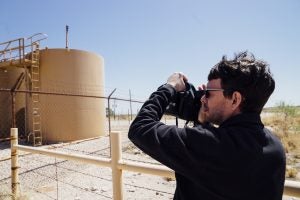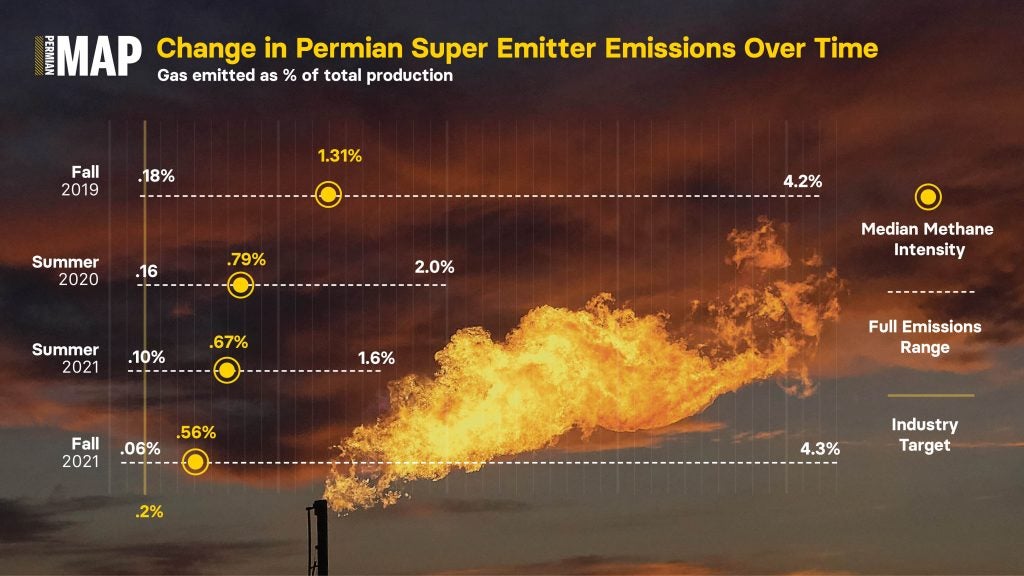Key things we learned from studying methane in the nation’s largest oilfield
 By Ben Hmiel and Jon Goldstein
By Ben Hmiel and Jon Goldstein
After three years of actively collecting methane emissions data in the Permian Basin, researchers have gained new insights that will make it easier to reduce emissions of the incredibly potent greenhouse gas methane. These insights are helping inform state and federal regulatory approaches at a critical time.
Researchers with the Permian Methane Analysis Project (PermianMAP) started studying emissions in the United States’ largest oil field back in 2019. Over the course of 3 years (both pre- and post-pandemic), we used a network of aircraft, cell towers, satellites and a mobile laboratory to collect and analyze emissions data from the region’s oil and gas facilities.
WATCH: Mapping methane in the Permian Basin
At first, the results were stark. Emissions were pouring out of the region’s oil and gas facilities at a rate 3 times higher than what the U.S. Environmental Protection Agency previously thought. And we learned the practice of flaring generates massive amounts of methane pollution from flare stacks that frequently malfunction or become unlit.
We also learned that the region’s smaller wells – often older well sites that produce less than 15 barrels of oil/gas in a day – generate roughly half of all well-site emissions. And leaks from gathering lines – the network of pipes that move gas from well sites to processing facilities – have emissions and leaks that are at least 14 times higher than official estimates.
The catastrophic amounts of methane found is certainly not good news, but it does shed important light on where operators and regulators can deploy solutions. And it has given new weight to the value that regular monitoring and measurements can play in reducing emissions.
Using data from a series of aerial campaigns conducted from 2019 through 2021, we tracked the methane intensity (how much gas escapes as a percentage of overall gas production) for several large producers in the Permian.
While there are challenges and uncertainties associated with snapshot measurements, we found the median and lower range consistently decreased over the course of the four campaigns. And while there was still a range of low and high emissions intensity for these operators observed across the course of the project, there is both scientific and anecdotal evidence to suggest that paying attention to your methane footprint and increased monitoring – be it self appointed or coming from a watchdog – does have an impact on lowering the volume of methane from super-emitters in the oil and gas sector.
A collection of some of the world’s largest oil companies previously made a commitment to keep upstream methane intensity at .2% of production. Few operators in the Permian are close to hitting that target, according to our observations.
More about those watch dogs
Our research suggests that the public nature of this campaign (we published operator emissions data online through our data portal) could have been a factor in the declining emissions. And it creates a strong argument of the value that more oversight can play in delivering additional reductions.
State and federal environmental agencies have taken notice, and over the course of the project, some important methane policies have been introduced. The Environmental Protection Agency recently proposed an expansion to its methane regulations which require regular leak detection and repair at smaller wells with leak prone equipment. New rules in the state of New Mexico do the same and curb emissions and waste from routine flaring.
We need to continue to push for strong rules and enforcement at the national level – led both by the EPA and the Pipeline and Hazardous Materials Safety Administration – to ensure that operators are measuring emissions, fixing problems where they exist, and reporting their progress back to the regulators. EPA can and should follow New Mexico’s lead by finalizing standards that ensure small wells across the country are regularly inspected, and minimize the practice of routine flaring. Stronger pollution standards ultimately lead to fewer greenhouse gas emissions, reduced energy waste and improved air quality for the people living downwind.
The promise of measuring and data
It bears repeating that one significant conclusion of this work is that measuring methane does have a positive impact on reducing emissions. While the PermianMAP research project has drawn to a close (for now), it’s not the only methane monitoring project in the game. A whole network of greenhouse gas mapping satellites is helping to detect pollution from space. And airplanes equipped with methane monitors are able to scan large areas of oil and gas production – pinpointing hot spots of methane leakage that can help operators and regulators deploy solutions at the sites that need it most.











